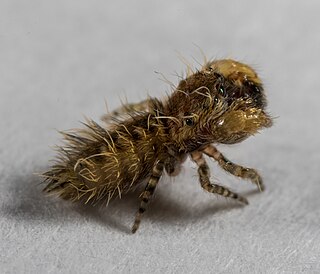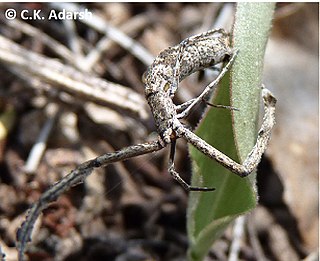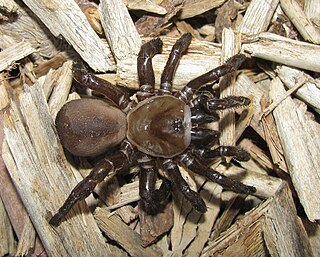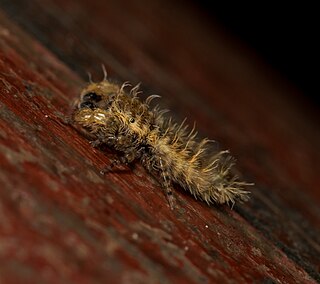
Wolf spiders are members of the family Lycosidae, from the Ancient Greek word "λύκος" meaning "wolf". They are robust and agile hunters with excellent eyesight. They live mostly in solitude and hunt alone, and do not spin webs. Some are opportunistic hunters pouncing upon prey as they find it or even chasing it over short distances. Some wait for passing prey in or near the mouth of a burrow.

Nursery web spiders (Pisauridae) is a family of araneomorph spiders first described by Eugène Simon in 1890. They resemble wolf spiders (Lycosidae) except for several key differences. Wolf spiders have two very prominent eyes in addition to the other six, while a nursery web spider's eyes are all about the same size. Additionally, female nursery web spiders carry their egg sacs with their jaws and pedipalps instead of attaching them to their spinnerets as wolf spiders do. When the eggs are about to hatch, a female spider builds a nursery "tent", places her egg sac inside, and stands guard outside, hence the family's common name. Like the wolf spiders, however, the nursery web spiders are roaming hunters that don't use webs for catching prey. They have a wide variety of prey, and larger species may prey upon vertebrates, particularly amphibians and fish.

The sac spiders of the family Clubionidae have a very confusing taxonomic history. Once, this family was a large catch-all taxon for a disparate collection of spiders, similar only in that they had eight eyes arranged in two rows and conical anterior spinnerets that touched, and were wandering predators that built silken retreats, or sacs, usually on plant terminals, between leaves, under bark, or under rocks. These are now recognized to include several families, some of which are more closely related to the three-clawed spiders, like lynx and wolf spiders, than to Clubionidae and related families.

Anyphaenidae is a family of araneomorph spiders, sometimes called anyphaenid sac spiders. They are distinguished from the sac spiders of the family Clubionidae and other spiders by having the abdominal spiracle placed one third to one half of the way anterior to the spinnerets toward the epigastric furrow on the underside of the abdomen. In most spiders the spiracle is just anterior to the spinnerets. Like clubionids, anyphaenids have eight eyes arranged in two rows, conical anterior spinnerets and are wandering predators that build silken retreats, or sacs, usually on plant terminals, between leaves, under bark or under rocks. There are more than 500 species in over 50 genera worldwide.

Hexathelidae is a family of mygalomorph spiders. It is one of a number of families and genera of spiders known as funnel-web spiders. In 2018, the family was substantially reduced in size by genera being moved to three separate families: Atracidae, Macrothelidae and Porrhothelidae. Atracidae includes the most venomous species formerly placed in Hexathelidae.

Dwarf sheet spiders (Hahniidae) is a family of araneomorph spiders, first described by Philipp Bertkau in 1878. Their bodies are about 2 millimetres (0.079 in) long, and they build extremely delicate webs in the form of a sheet. Unlike many spiders the web does not lead to a retreat. The silk used in these webs is so fine that they are difficult to spot unless they are coated with dew. They greatly favor locations near water or near moss, and are often found in leaf litter and detritus or on the leaves of shrubs and trees.

Hersiliidae is a tropical and subtropical family of spiders first described by Tamerlan Thorell in 1870, which are commonly known as tree trunk spiders. They have two prominent spinnerets that are almost as long as their abdomen, earning them another nickname, the "two-tailed spiders". They range in size from 10 to 18 mm long. Rather than using a web that captures prey directly, they lay a light coating of threads over an area of tree bark and wait for an insect to stray onto the patch. When this happens, they encircle their spinnerets around their prey while casting silk on it. When the insect is immobilized, they can bite it through the shroud.

Attulus is a genus of jumping spiders that was first described by Eugène Louis Simon in 1889. The name is a diminutive form of a common prefix for salticid genera, -attus.

Chalcoscirtus is a genus of jumping spiders that was first described by Philipp Bertkau in 1880. The name is derived from the Ancient Greek chalc-, meaning "copper", and scirt-, meaning "leap".

Salticus is a genus of the family Salticidae. Salticus is the type genus for the family Salticidae.
Stertinius is a genus of Asian jumping spiders that was first described by Eugène Louis Simon in 1890.

Uroballus is a spider genus of the jumping spider family, Salticidae. It includes five or six accepted species.

Hersilia, also known as long-spinnered bark spiders and two-tailed spiders, is a genus of tree trunk spiders that was first described by Jean Victoire Audouin in 1826. Their nicknames are a reference to their greatly enlarged spinnerets.
Uroballus peckhami is a spider species of the jumping spider family, Salticidae that is known only from northern Vietnam.

Miagrammopes is a genus of cribellate orb weavers first described by Octavius Pickard-Cambridge in 1870. These spiders have a unique shape and only four of their original eight eyes. They spin a single line of web, actively watching and jerking the line to catch their prey.
Uroballus henicurus is a species of spider of the genus Uroballus. It is endemic to Sri Lanka.
Uroballus octovittatus is a species of spider of the genus Uroballus. It is endemic to Sri Lanka.

Halonoproctidae is a family of mygalomorph spiders, split off from the family Ctenizidae in 2018. Species in the family are widely distributed in North and Central America, Australasia, Asia, southern Europe and North Africa. One species is recorded from Venezuela in South America. They are relatively large, sombrely coloured spiders, that live in burrows with some kind of trapdoor.
Uroballus koponeni is a species of spider of the genus Uroballus. It is endemic to the Malaysian part of Borneo.

Uroballus carlei is a species of spider of the genus Uroballus. It has only been found in Hong Kong.














